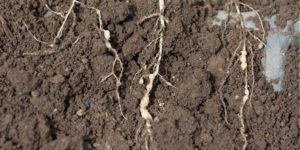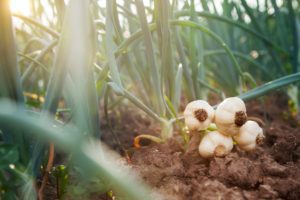Parsley is a biennial culinary herb of the Umbelliferae/ Apiaceae family which is commercially cultivated as an annual in many parts of the world for its attractive and aromatic leaves.
The herb is used in flavouring salads, soups and meat among other dishes, and is also used for garnishing. Leaves are used fresh or dried as a culinary herb, the taproot cultivars is edible and may be eaten as a vegetable. Oil can be extracted from the parsley flowers and is used as a flavoring.
It contains Vitamins A, C and K, among other minerals and can be used for neutralizing strong smelling breath
Parsley has an erect growth habit and possesses branched, hollow stems and dark green flat or curled leaves which are arranged alternately on the stems. These leaves form a rosette on younger plants. The plant produces small, yellow flowers on umbels. It can reach 30–80 cm in height depending on the variety.
Ecological Requirements
The herb grows well in moist, well-drained, moisture retaining and fertile soils with an optimum soil pH between 5.5 to 7.5.
It requires a good amount of light and will do best when receiving about 6 hours of sunlight a day, but can tolerate partial shade.
Plants grow best at temperatures between 7-16 degrees centigrade.
Planting & Cultural Practices
Propagation is by seeds, which are planted/drilled directly into the ground.
Garden preparation
- Choose a site that is flat and where crops belonging to the same family as coriander have not been cultivated for about 4-7 months.
- Spray land with CLAMPDOWN 480SL 200ml/20l in order to get rid of all types of weeds.
- Prepare a fine tilth. Mix soil with manure and DAP. In order to stimulate root development, improve nutrient uptake levels, improve the soil structure, among other benefits, incorporate manure (1 ton) and DAP 50kg (50kg) with 1 kg HUMIPOWER.
- Raise planting beds, about 15cm high by 1m bed top then by desired length and make rows.
- Plant the seed about 133gms/100m bed length of 1m top, then water the beds/field.
- Drench soil with a mixture of PYRAMID 700WP 100g + LOYALTY 700WDG 10g + OPTIMIZER 20ml in 20l of water. This helps in getting control of soil pests and diseases as well as breaking seed dormancy and promoting uniform germination of the seedlings.
Planting
- Soak seeds in OPTIMIZER 20ml/1l overnight for better germination.
- Drill seeds in the rows, about 0.25 inches deep.
- Cover seeds with a thin layer of soil and water them with a light water shower.
- Cover seeds with a thin layer of dry grass (mulch)
Seeds may take up to 18 – 25days to germinate, and that is why it is advisable to soak them in Optimizer before planting.
Thinning– after emergence, seedlings should be thinned to a final spacing of 3 – 4cm apart, leaving 10 – 15 in between rows. This encourages air circulation and reduces competition for growth factors.
Weeding– weeds should be removed from around parsley plants by carefully hand weeding.
Mulching- a layer of mulch applied around the plants helps suppress weeds as well as retaining soil moisture. When the mulch decomposes, it releases nutrients into the soil, which are absorbed by the plants.
Irrigation-before the seeds germinate, it is important to water the ground well in order to ensure that the soil has consistent moisture levels, which are critical for germination. The herb will also need to be watered gently throughout its growth cycle. It is recommended that the soil moisture be monitored before repeating the irrigation cycle whenever necessary.
Note;
- Spacing between rows should be 10-15cm.
- Plants can be kept productive by clipping the branches, which helps to promote new growth. Any flower stalks should be removed as they bulbing during the first year of growth to prevent the plant from seeding hence retaining the flavor of the leaves.
Pests & Disease Control
Pests
Armyworms– symptoms showing infestation include singular, or closely grouped circular to irregularly shaped holes in foliage, heavy feeding by young larvae which leads to skeleton zed leaves, shallow, dry wounds on fruit and egg clusters of army be present on the leaves, which are covered in a whitish scale giving them a cottony or fuzzy appearance.
Spray KINGCODE ELITE 50EC 10ml/20l or SINOPHATE 750SP 20g/20l or LEXUS 247SC 8ml/20l
Aphids– these are small soft bodied insects that are mostly found on the underside of leaves and/or stems of plant, usually green or yellow in color. Infestation causes leaves to turn yellow and/or be distorted, form necrotic spots and stems may get stunted. Aphids excrete a sticky sugary substance called honeydew (Excess sugar) which encourages the growth of sooty mold.
Spray PENTAGON 50EC 10ml/20l or KINGCODE ELITE 50EC 10ml/20l or EMERALD 200SL 10ml/20l
To get rid of the sooty mold, spray JAMBO CLEAN 100ml/20l
Cutworms– stems of young transplants or seedlings are cut at soil line by the worms.
Dress seeds with SHIELD 600FS 3ml/kg
Drench soil with PROFILE 440EC 60ml/20l or PENTAGON 50EC 20ml/20l
Root knot nematode– infestation causes formation of galls on roots, reduction in plant vigor and yellowing of plants which eventually wilt.
Drench soil with ALONZE 50EC 10ml/20l or mix fertilizer 50kg with ADVENTURE 0.5GR 2kg whenever doing basal application of fertilizer, e.g. DAP, CAN etc.
Carrot Root Fly – the worms feed on the root matter and are usually the main cause for stunted parsley growth.
Spray PRESENTO 200SP 5g/20l or LEXUS 247SC 8ml/20l or PENTAGON 50EC 10ml/20l
Diseases
Leaf Spot –yellow spots form on the foliage and darken to brown with a golden halo. Leaves wilt and may fall off and the entire plant is weakened. The disease can cause entire crops to fail if not controlled in time.
Spray RANSOM 600WP 15g/20l or JUPITER 125SC 15ml/20l or DOMAIN 250EC 10ml/20l
Gray mold/Botrytis –infection starts out with brown to black spots on the leaves. As it progresses, white-gray fungal growth develops on all leaf surfaces. Leaves fail to thrive and eventually die.
Spray EXEMPO CURVE 250SC 15ml/20l or EXPLORER 3SL 10ml/20l or KATERINA 720SC 40ml/20l
Damping-off– symptoms due to infection are soft, rotting seeds which fail to germinate, rapid death of seedling prior to emergence from soil and collapse of seedlings after they have emerged from the soil, which is due to the water-soaked reddish lesions girdling the stem at the soil level.
Drench soil with PYRAMID 700WP 100g/20l
Spray CHANCETYL ELITE 800WDG 50g/20l or MILLIONAIRE 690WDG 40g/20l
Rust– disease leads to formation of light green discolored lesions on leaves which become chlorotic after sometime, yellow-orange pustules on underside of leaves, stems bend and become swollen or distorted and plants may be stunted.
Spray DUCASSE 250EW 20ml/20l or RANSOM 600WP 15g/20l or MILESTONE250SC 10ml/20l
Alternaria leaf blight– brown-black necrotic lesions form on leaves which may have chlorotic margins. These lesions expand and coalesce causing the death of leaves and petioles. Dark necrosis also occurs on crown and upper region of taproot.
Spray GEARLOCK TURBO 250WP 25g/20l or FORTRESS GOLD 720WP 40g/20l or RIMETA GOLD 300SC 40ml/20l
Powdery mildew– infection causes a whitish powdery growth on leaves, petioles flowers stalks and bracts. Leaves become chlorotic and severe infections can cause flowers to become distorted and whitish leaves which are not useable
Spray RANSOM 600WP 15g/20l or DUCASSE 250EW 20ml/20l or ABSOLUTE 375SC 10ml/20l
Cercospora leaf blight– small, necrotic flecks form on leaves which develop a chlorotic halo and expand into tan brown necrotic spots. These lesions coalesce and cause leaves to wither, curl and eventually die.
Spray GEARLOCK TURBO 250WP 25g/20l or FORTRESS GOLD 720WP 40g/20l or TOWER 720WP 50g/20l
Maturity, Harvesting & Post-Harvest Handling
Parsley matures when the leaf stems have three segments. Ideally, this should occur 70-90 days after planting.
Harvesting can be done through picking the leaves or cutting the stems off, especially when harvesting for commercial purposes.
The outermost stalks, just above ground level should be cut first. This encourages further growth. Cutting near the top of the stalks does not encourage such vigorous re-growth.
Parsley can be dried or frozen for longer storage.
For the fresh market, bunches of parsley should be washed and any faded or yellowing leaves discarded. Parsley may be packed and shipped hydro cooled or package iced to maintain crispness and fresh appearance.
Parsley is shipped in wooden bushels or in wax, corrugated universal cartons.
The optimum storage and handling temperatures are 32-36° F at 95% relative humidity.






